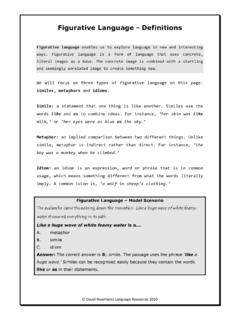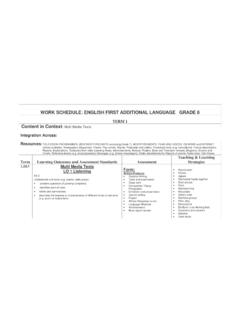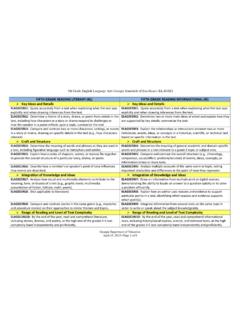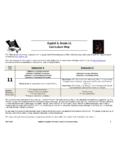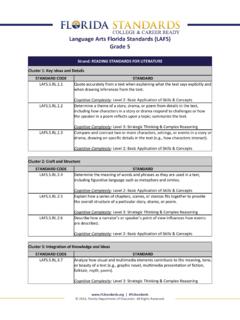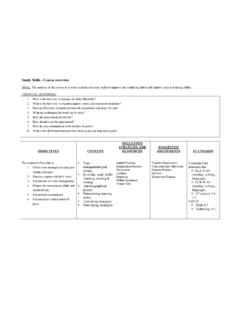Transcription of READING LITERARY (RL) READING INFORMATIONAL …
1 4th Grade English language Arts georgia standards of Excellence (ELAGSE) READING LITERARY (RL) READING INFORMATIONAL (RI) Key Ideas and Details Key Ideas and Details ELAGSE4RL1: Refer to details and examples in a text when explaining what the text says explicitly and when drawing inferences from the text. ELAGSE4RI1: Refer to details and examples in a text when explaining what the text says explicitly and when drawing inferences from the text. ELAGSE4RL2: Determine a theme of a story, drama, or poem from details in the text; summarize the text. ELAGSE4RI2: Determine the main idea of a text and explain how it is supported by key details; summarize the text.
2 ELAGSE4RL3: Describe in depth a character, setting, or event in a story or drama, drawing on specific details in the text ( , a character s thoughts, words, or actions). ELAGSE4RI3: Explain events, procedures, ideas, or concepts in a historical, scientific, or technical text, including what happened and why, based on specific information in the text. Craft and Structure Craft and Structure ELAGSE4RL4: Determine the meaning of words and phrases as they are used in a text, including those that allude to signifi cant characters found in mythology ( , Herculean). ELAGSE4RI4: Determine the meaning of general academic language and domain-specific words or phrases in a text relevant to a grade 4 topic or subject area.
3 ELAGSE4RL5: Explain major differences between poems, drama, and prose, and refer to the structural elements of poems ( , verse, rhythm, meter) and drama ( , casts of characters, settings, descriptions, dialogue, st age directions) when writing or speaking about a text. ELAGSE4RI5: Describe the overall structure ( , chronology, comparison, cause/effect, problem/solution) of events, ideas, concepts, or information in a text or part of a text. ELAGSE4RL6: Compare and contrast the point of view from which different stories are narrated, including the difference between first- and third-person narrations. ELAGSE4RI6: Compare and contrast a firsthand and secondhand account of the same event or topic; describe the differences in focus and the information provided.
4 Integration of Knowledge and Ideas Integration of Knowledge and Ideas ELAGSE4RL7: Make connections between the text of a story or drama and a visual or oral presentation of the text identifying similarities and differences. ELAGSE4RI7: Interpret information presented visually, orally, or quantitatively ( , in charts, gr aphs, diagrams, time lines, animations, or interactive elements on Web pages) and explain how the information contributes to an understanding of the text in which it appears. ELAGSE4RL8: (Not applicable to literature) ELAGSE4RI8: Explain how an author uses reasons and evidence to support particular points in a text. ELAGSE4RL9: Compare and contrast the treatment of similar themes and topics ( , opposition of good and evil) and patterns of events ( , the quest) in stories, myths, and traditional literature from different cultures.
5 ELAGSE4RI9: Integrate information from two texts on the same topic in order to write or speak about the subject knowledgeably. Range of READING and Level of Text Complexity Range of READING and Level of Text Complexity ELAGSE4RL10: By the end of the year, read and comprehend literature, including stories, dramas, and poetry, in the grades 4-5 text complexity band proficiently, with scaffolding as needed at the high end of the range. ELAGSE4RI10: By the end of the year, read and comprehend INFORMATIONAL texts, including history/social studies, science, and technical texts, in the grades 4-5 text complexity band proficiently, with scaffolding as needed at the high end of the range.
6 4th Grade English language Arts georgia standards of Excellence (ELAGSE) Print Concepts Kindergarten and 1st grade only Phonological Awareness Kindergarten and 1st grade only Phonics and Word Recognition READING FOUNDATIONAL (RF) ELAGSE4RF3: Know and apply grade-level phonics and word analysis skills in decoding words. a. Use combined knowledge of all letter-sound correspondences, syllabication patterns, and morphology ( , roots and affixes) to read accurately unfamiliar multi-syllabic words in context and out of context. Fluency ELAGSE4RF4: Read with sufficient accuracy and fluency to support comprehension. a. Read on-level text with purpose and understanding.
7 B. Read on-level prose and poetry orally with accuracy, appropriate rate, and expression on successive readings. c. Use context to confirm or self-correct word recognition and understanding, rereading as necessary. 4th Grade English language Arts georgia standards of Excellence (ELAGSE) Text Types and Purposes WRITING (W) ELAGSE4W1: Write opinion pie ces on topics or texts, supporting a point of vie w with re asons. a. Introduce a topic or text clearly, state an opin io n, and create an organiz ational structure in which re la ted id eas are grouped to support the writer s purpose. b. Pr ovid e re asons that are supported by facts and detail s.
8 C. Lin k opin ion and re asons usin g words and phrases ( , for in stance, in ord er to, in additi on). d. Pr ovid e a concludin g statement or section re la ted to the opin ion presented. ELAGSE4W2: Write informative/expla natory texts to examine a topic and convey id eas and in formation clearly. a. Introduce a topic clearly and group re la ted in formation in paragraphs and sections; in clude formatting ( , headin gs), illustrations, and multi media when useful to aid in g comprehensio n. b. Develop the topic with facts, definiti ons, concrete detail s, quotations, or other information and example s re la ted to the topic. c. Lin k id eas wit hin categories of in formation usin g words and phrases.
9 ( , another, for example , also, because). d. Use precise language and domain-specific vocabulary to inform about or explain the topic. e. Pr ovid e a concludin g statement or section re la ted to the in formation or expla nation presented. ELAGSE4W3: Writ e narra tives to develop real or imagin ed experiences or events usin g effective technique, des crip tive details, and cle ar event sequences . a. Ori ent the re ader by establi shin g a sit uation and in troducing a narrator and/or characters ; organiz e an event sequence that unfolds naturally. b. Use dialogue and description to develop experi ences and events or show the responses of characters to sit uatio ns.
10 C. Use a variety of tra nsiti onal words and phrases to manage the sequence of events. d. Use concrete words and phra ses and sensory detail s to convey experi ences and events pre cisely . e. Pr ovid e a conclusion that follows from the narrated experi ences or events. Production and Distribution of Writing ELAGSE4W4: Pr oduce clear and cohere nt writing in which the develo pment and organiz ation are appropriate to task, purp ose, and audie nce. (Gra de-specific expectations for writing types are defined in standards 1 3 above.) ELAGSE4W5: With guid ance and support fro m peers and adult s, develop and strengthen writing as needed by pla nning, revisin g, and editi ng.










